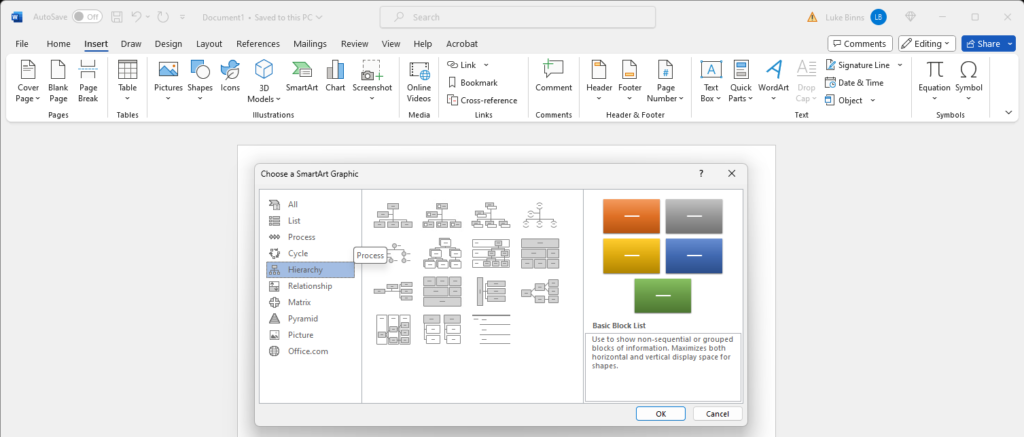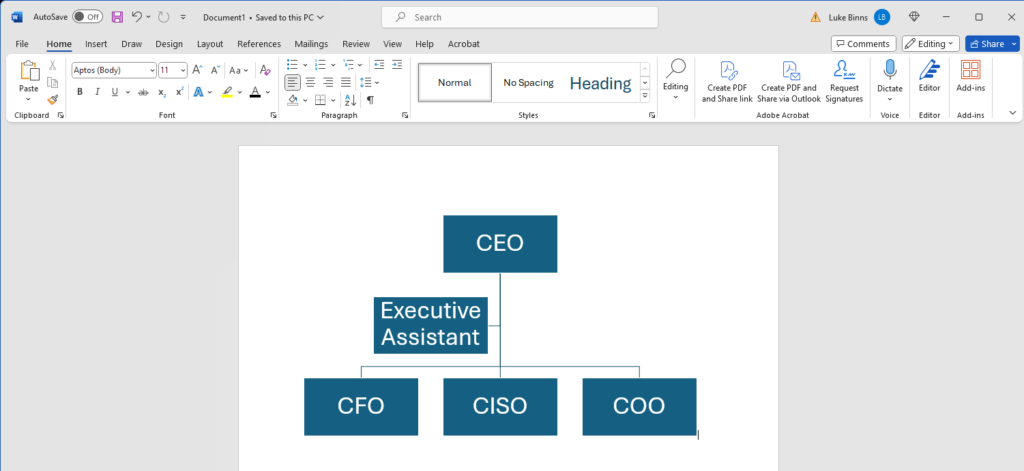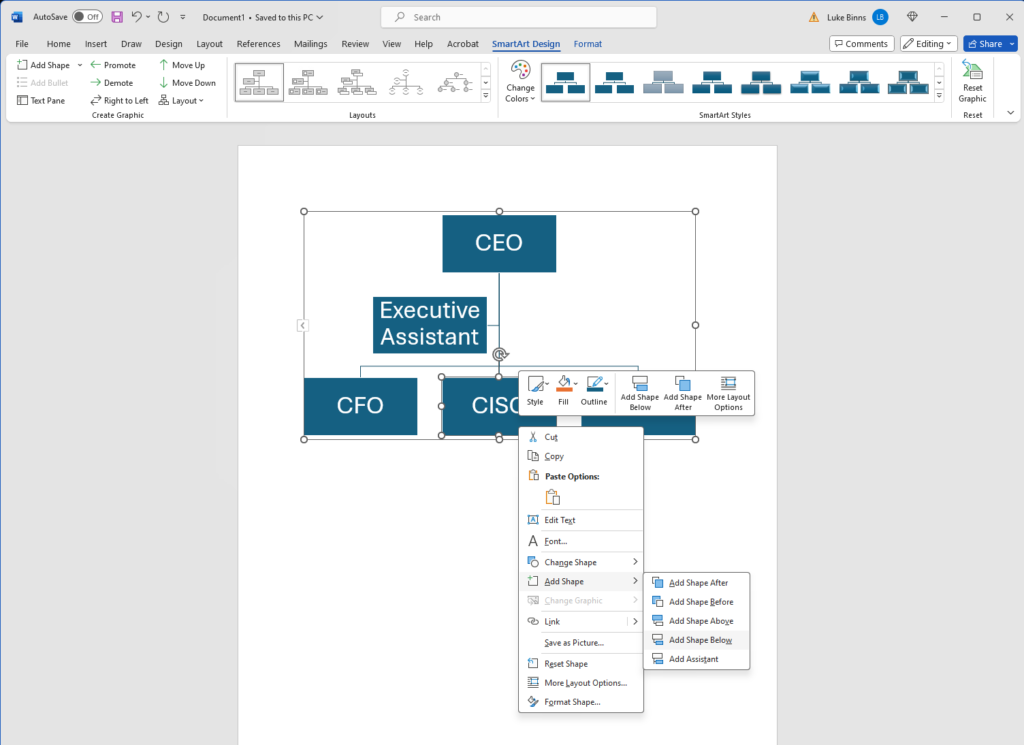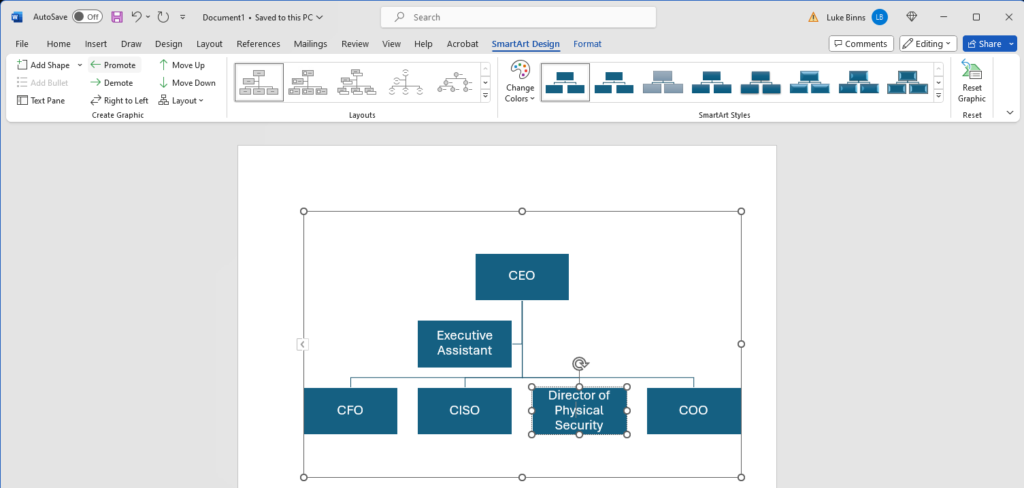Organizational charts, commonly known as org charts, act as important guides for helping employees and other stakeholders to understand the layout and reporting relationships within a business or project. These diagrams display the connections among various positions, sections, and people, offering insight into the complex structure that shapes an organization’s functioning.
Org charts are crucial for revealing lines of communication and demonstrating levels of authority. In this tutorial, we will look at how you can create your organizational chart using Microsoft Word and introduce you to alternative options like Organimi, our sophisticated online org chart creation tool.
What Is an Org Chart?
An org chart is a visual tool used to depict the structure of an organization, showcasing the relationships and relative ranks of its various roles and positions. It typically illustrates the hierarchy within the organization, delineating who reports to whom.
This helps understand the chain of command and the flow of authority and responsibility. Org charts also detail the different roles and departments, clarifying the organization’s internal division of labor and how each segment fits into the larger structure.
Additionally, organizational charts can indicate lines of communication and coordination, providing a clear view of how information flows between levels and departments. This makes org charts essential for planning and managing an organization’s structure and for new employees to understand their role within the larger context.
How to Build an Org Chart in Microsoft Word
Microsoft Word is more than just a word-processing tool. It’s a flexible piece of software that can be used for various purposes, from writing a novel to designing business cards. It also has native functionality for building organizational charts using the SmartArt feature. Here’s how to build your own (basic) organizational chart in Word in as little as five minutes.
1. Insert SmartArt
Building an org chart in Microsoft Word requires the use of SmartArt functionality. In your document, go to the Insert tab and click on SmartArt to begin. A window will pop up, prompting you to choose a SmartArt graphic. Navigate to the Hierarchy option and select an org chart template from the options.

2. Enter Your Text
You can now click into the shapes and add text. Each shape in the chart represents an individual within the organization, and you’ll need to manually fill them out accordingly.

3. Add Shapes
You’ll probably need more shapes than the default template includes. To do this, click the SmartArt Design tab and select Add Shape from the top-left side of the options ribbon. You can select where this new shape goes by clicking on an existing shape in the org chart.
For instance, if you wanted to add a subordinate to the CISO, you would right-click the CISO shape before clicking Add Shape.

4. Flesh Out Your Hierarchy
When you’ve added all your individuals and roles, you can rearrange the hierarchy by clicking on the individual you wish to move and using the Promote, Demote, Move Up, or Move Down options from the SmartArt Design menu.
As you can see, promoting the ‘Director of Physical Security’ moves that individual one level up the chain of command.

5. Format Your Design
When you’re happy with the overall layout of your org chart, you can then use the various design options to customize the look and feel of it by modifying colors, fonts, layout styles, and more.
Microsoft Word Org Chart Limitations
Building a simple org chart in Microsoft Word is a quick and easy task, but therein lays the problem—it’s simple. Microsoft Word has serious limitations when it comes to building more complicated charts that most businesses above the start-up level will need.
Word’s built-in org chart templates might not accommodate complex organizational structures or non-traditional hierarchies. This means that creating custom designs can be cumbersome and time-consuming, if not impossible.
These limitations also stretch to collaboration. Multiple users working on the same file simultaneously can lead to version control issues or conflicting changes. Word’s org charts are also static. They lack the interactivity and dynamic features required for real-time updates or drill-down capabilities that could showcase detailed information about specific departments or roles.
As organizations grow or change, updating org charts in PowerPoint also becomes problematic. Keeping them current with staffing changes or structural modifications can be labor-intensive.
Using Organimi to Build Powerful Org Charts
If you’ve tried building your org chart in Microsoft Word and find that the above limitations resonate with you, we recommend using Organimi.
Organimi was designed specifically for creating powerful organizational charts, so you won’t run into any of the frustrating limitations that exist in Microsoft Word. Using a wide range of tools and integrations, you can build large, complex organizational charts in a matter of minutes.
Getting Started with Organimi
Sign up for a free Organimi account and open a new Organimi workspace to begin diagramming. Our intuitive interface and a wide variety of features make it easy to get started without being bogged down by a huge learning curve.
Drag-and-Drop Building: Organimi has been designed specifically for building org charts, meaning you can build a chart that would take hours in PowerPoint in a matter of minutes using our native design features.
Endless Integrations: Organimi Connect has pre-built connectors for Microsoft, Google, Salesforce, and more. Keep your chart up to date in real-time, all the time, with comprehensive integration solutions, or connect it with your existing HR solution.
SmartChart™ Legend: Use Organimi’s unique SmartChart™ Legend feature to help visualize information on your chart and attach conditions to custom fields. Organimi’s flexible formatting and branding options make your chart even more visually appealing.
Presentation-Ready Charts: If using PowerPoint is a must for you, no problem! Organimi charts can easily be inserted into presentations by exporting them as PDF, PNG, or PPTX files. Let Organimi do the work for you by automatically splitting your chart across different pages and slides.

